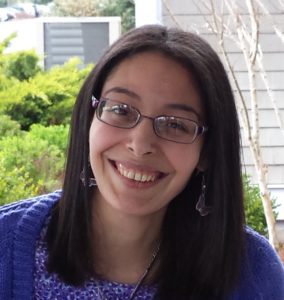“Hi, I’m Rachael, and I’m forever 33.”

When Debbie Kaflowitz remembers her daughter, she thinks about everything that Rachael loved to do. Rachael enjoyed dancing and performing in ballet recitals, dancing all the way through eighth grade. She had a way with children, Debbie says, which made her a phenomenal camp counselor. She knew each child’s stop, took notes from parents, decorated the bus, and altogether created a fun atmosphere. Remembering Rachael is bittersweet; she passed away on October 25, 2018, from late-onset Niemann-Pick disease type C (NPC).
Getting the correct diagnosis for Rachael took 12 years. During that time, Debbie combed the internet and sought doctor after doctor, looking for someone who could diagnose and cure Rachael. Finally after 12 years, Debbie and her husband learned the devastating news that Rachael had NPC. She would continue to decline before ultimately passing away.
There was no treatment, no cure.
Debbie explains:
As a mother, you have dreams. I wanted Rachael to be happy and have lots of friends. I was expecting to share experiences with her, such as setting up a college room, celebrating a first job, shopping for a wedding dress, walking her down the aisle, and becoming a grandmother. Suddenly, all those dreams were taken away from Rachael and our family.
After Rachael’s passing, Debbie has channeled her energy into helping the greater NPC community. She tries to raise awareness. To fight for medication access. To educate others on what NPC is and why it matters. Join Patient Worthy in learning more about Rachael’s story.
Niemann-Pick Type C
Niemann-Pick disease type C (NPC) is an ultra-rare, genetic, degenerative, fatal disease that affects the body’s ability to metabolize cholesterol and other fatty substances (lipids) inside of cells. In a healthy body, cholesterol and lipids are broken down and recycled. With NPC, these can’t be broken down, so they accumulate in the cells. This causes the brain cells to malfunction, and eventually die, causing neurological and systemic decline.
Symptoms vary from patient-to-patient, but most often involve the progressive loss of ambulation and motor skills, speech, cognition, and swallowing. NPC has been compared to the cognitive decline and short-term memory loss of Alzheimer’s, the ataxia and tremors of Parkinson’s, and the systemic decline of ALS. Visible symptoms of NPC can vary widely, sometimes showing up at birth or infancy, other times, appearing seemingly out of nowhere, in late childhood to adulthood. Generally, the earlier the disease onset, the more aggressive the disease progression.
While Rachael did show some symptoms while she was growing up, the larger manifestations of her illness didn’t appear until she was older, characterizing her NPC as adult-onset.
Symptoms associated with NPC may include:
- Jaundice (yellowing of the skin, eyes, and mucous membranes)
- Eye paralysis (in terms of vertical movement)
- Hypotonia (poor muscle tone)
- Clumsiness and difficulty coordinating movements
- Neurological symptoms which may be misdiagnosed as psychiatric
- Enlarged spleen and/or liver
- Difficulty swallowing
- Memory loss
- Changes in speech, such as slurring
- Hearing loss
- Dementia
Unfortunately, NPC is a fatal disease for which no FDA-approved treatments are available in the U.S. and only limited options in the rest of the world. While some therapies have shown promise in alleviating some symptoms or slowing the progression of NPC, many families have difficulty accessing these options.
If you would like to learn more about NPC, take a look at this National Niemann-Pick Disease Foundation overview.
Rachael’s Story
June 21, 1985: the day that Rachael Kaflowitz came into the world. “Rachael was born five weeks early. We were thrilled we had a healthy baby, even though she was so early.” Although, as Debbie explains, Rachael was a little delayed on some milestones, Debbie never originally thought that there was anything wrong with her daughter.
Rachael brought joy to her parents’ lives as she grew. But then Debbie began having a gut feeling that put her on alert. She tells a story of how Rachael and her friend Ali were performing a magic trick:
Ali held up a handkerchief and said, ‘See, no hole.’ Rachael turned it around and said, ‘See, no hole on this side either!’ By that point in Rachael’s development, she should have realized that a hole goes all the way through. But nobody goes looking for doctors when something like that happens. I certainly didn’t think she had a fatal disease.
As Rachael progressed into elementary school, it soon became clear that she had a learning disability. She struggled with reading and processing. But Debbie felt frustrated by the fact that nobody would agree to evaluate her. As a parent, and educator for 32 years, she explains:
Rachael was cute and well-behaved. If she had been rambunctious, she would have been evaluated. But people sometimes brush off your concerns as, ‘She looks like she is paying attention, so she must be understanding everything.’
In 3rd grade, Debbie brought up her concerns with Rachael’s teacher, who stated that Rachael seemed to be concentrating. But when Debbie asked her to watch Rachael turn to a specific page, the teacher suddenly noticed that Rachael couldn’t figure out which way to go. She kept turning the pages back and forth, waiting for page 35 to pop out. This was not the only processing difficulty seen over the years, says Debbie:
I had a picture of her brain where a thought would fly off one synapse going, ‘Where do I go? Where do I go?’ She had a lot of half ideas. She’d say, ‘Turn on the air conditioner, I’m cold,’ knowing that it made things cold but you turn it on when you’re hot. When playing volleyball, she couldn’t seem to figure out where the ball was going. She knew her birthday was June 21st but got a lot of other holidays, days, and numbers mixed up.
While Debbie was concerned, she was not yet worried enough to find a doctor.
The Beginning of the Diagnostic Journey
However, Debbie’s concerns began to grow when Rachael moved into middle school. Rachael had difficulty processing multi-person or multi-topic conversations. If a group was talking about movies, a math test, then jeans, Rachael would suddenly bring up movies again. All her peers would roll their eyes. This made it difficult for her to make friends, says Debbie. She also struggled with processing information during class and coming away with a full understanding of what the teacher said. Debbie laughs when she recounts a story to me:
She came home and said, ‘We’re reading a new book in school. It’s about tequila.’ My husband and I laughed and said we didn’t think so. When we asked Rachael what else it was about, she said, ‘Oh, there’s a bird in it.’ Can you guess what it was? To Kill a Mockingbird.
While she sometimes had difficulty at school, Rachael excelled at camp. She poured her heart into theater and arts and crafts. When she made friends, she was excited to be part of a group.

She just dissolved, and everything fell apart. One day in the kitchen, she said to my husband that she wanted an apple, and he told her where to find the peeler. Then Rachael said, ‘I don’t know what a peeler is, and I should.’ She suddenly couldn’t put thoughts together. She was crying all of the time. She was scared that people were coming to kill us. When she found a nail outside the door, she thought someone had been trying to break in. My gut feeling of a learning disability turned into knowing, without a doubt, that something was terribly wrong with Rachael.
After visiting many doctors who ruled out a brain tumor and Lyme disease, along with other diseases, Debbie brought Rachael to a psychiatrist named Dr. Behar. Dr. Behar tried a variety of medications to stabilize Rachael. When other psychological symptoms appeared, Dr. Behar diagnosed Rachael as bipolar, a perfectly reasonable diagnosis.
Unfortunately, during this time, her medications didn’t seem to be working quite the way they should. Rachael was in and out of the hospital, but was never totally stabilized. When the medicine would stop working, Dr. Behar would start again with new combinations of medications. New symptoms began popping up, but these could all be written off as side effects: stumbling (lithium), difficulty swallowing (Risperdal). This is where doctors and parents get stuck, says Debbie. It’s hard to make a case that something else is wrong if someone can find a potential reason to explain a symptom.
Paging Dr. Behar
One thread which stayed constant throughout our interview is Debbie’s gratefulness for Dr. Behar. During the entire process, he continued advocating for Rachael and fought to receive an accurate diagnosis. Rachael’s cognitive ability started to decline, for which there was no apparent reason. That’s when Dr. Behar told Debbie that he suspected Rachael had something genetic. She says:
Without him saying that, who knows if we would’ve ever known what was wrong with Rachael before she died.
At a yearly conference for psychiatrists, Dr. Behar participated in a breakout group for genetic illnesses that mimic bipolar. During this group, he learned about NPC, which had many similarities with Rachael’s case: “They just described Rachael!” He called Debbie to tell her that he had discovered a potential diagnosis. It took two months for Rachael to get an appointment with a neurogeneticist. The neurogeneticist checked Rachael’s eyes by asking her to follow his finger. Then he repeated it, asking her not to move her head when she looked down. Finally, he held Rachael’s head still while she looked down. Next he brought in an optogeneticist who did the same thing. Debbie explains:
When they did the exact same thing, I realized they knew what was wrong. Rachael had vertical gaze palsy, one of the most common symptoms that indicates NPC. Although it had to be confirmed with blood tests, the doctor was able to diagnose Rachael within five minutes. I always say her entire diagnostic journey was 12 years and 5 minutes.
Receiving a diagnosis was rife with mixed feelings. Learning that Rachael had NPC first paralyzed the family with fear, but there was also some strange relief involved. Debbie says:
Not knowing what was happening to Rachael was worse than knowing. We thought, ‘Now we can make decisions. We’re no longer searching for the diagnosis; we’re figuring out what to do next.’
To learn more about Rachael’s story, stay tuned for Parts 2 and 3 — coming soon.






